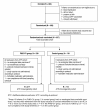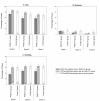Primary vaccination with the 10-valent pneumococcal non-typeable Haemophilus influenzae protein D conjugate vaccine (PHiD-CV) in infants in Mali and Nigeria: a randomized controlled trial
- PMID: 22112189
- PMCID: PMC3267728
- DOI: 10.1186/1471-2458-11-882
Primary vaccination with the 10-valent pneumococcal non-typeable Haemophilus influenzae protein D conjugate vaccine (PHiD-CV) in infants in Mali and Nigeria: a randomized controlled trial
Abstract
Background: Pneumonia is still the leading cause of death among children in Africa, and pneumococcal serotypes 1 and 5 are frequently isolated from African children with invasive pneumococcal disease below the age of 5 years. The immunogenicity, safety and reactogenicity of 3-dose primary vaccination with the 10-valent pneumococcal non-typeable Haemophilus influenzae protein D conjugate vaccine (PHiD-CV) were evaluated in infants in Mali and Nigeria.
Methods: In an open, randomized, controlled study, 357 infants received DTPw-HBV/Hib and OPV primary vaccination with (PHiD-CV group) or without (control group) PHiD-CV co-administration at 6, 10 and 14 weeks of age. Pneumococcal antibody responses and opsonophagocytic activity (OPA) were measured and adverse events (AEs) recorded.
Results: One month post-dose 3, ≥ 97.2% of PHiD-CV-vaccinated infants had an antibody concentration ≥ 0.2 μg/mL for each vaccine pneumococcal serotype except for 6B (82.0%) and 23F (87.6%) versus < 10% in the control group except for serotypes 14 (35.7%) and 19F (22.5%). For each vaccine serotype, ≥ 93.3% of PHiD-CV recipients had an OPA titre ≥ 8, except for serotypes 1 (87.6%) and 6B (85.4%), compared to < 10% in the control group, except for serotypes 7F (42.9%), 9V (24.1%) and 14 (24.5%). Anti-protein D geometric mean antibody concentrations were 3791.8 and 85.4 EL.U/mL in the PHiD-CV and control groups, respectively. Overall incidences of solicited and unsolicited AEs were similar between groups.
Conclusions: In sub-Saharan African infants, PHiD-CV was immunogenic for all vaccine pneumococcal serotypes and protein D. Vaccine tolerability was generally comparable between the PHiD-CV and control groups.
Trial registration: ClinicalTrials.gov identifier: NCT00678301.
Figures



Similar articles
-
Immunogenicity, safety and reactogenicity of the 10-valent pneumococcal non-typeable haemophilus influenzae protein D conjugate vaccine (PHiD-CV) in Nigerian Infants: a randomised trial.Niger Postgrad Med J. 2013 Dec;20(4):272-81. Niger Postgrad Med J. 2013. PMID: 24633268 Clinical Trial.
-
Safety, reactogenicity and immunogenicity of 2-dose catch-up vaccination with 10-valent pneumococcal non-typeable Haemophilus influenzae protein D conjugate vaccine (PHiD-CV) in Malian children in the second year of life: Results from an open study.Hum Vaccin Immunother. 2015;11(9):2207-14. doi: 10.1080/21645515.2015.1016679. Hum Vaccin Immunother. 2015. PMID: 26020101 Free PMC article. Clinical Trial.
-
Immunogenicity, impact on carriage and reactogenicity of 10-valent pneumococcal non-typeable Haemophilus influenzae protein D conjugate vaccine in Kenyan children aged 1-4 years: a randomized controlled trial.PLoS One. 2014 Jan 21;9(1):e85459. doi: 10.1371/journal.pone.0085459. eCollection 2014. PLoS One. 2014. PMID: 24465570 Free PMC article. Clinical Trial.
-
Immunogenicity of routinely used childhood vaccines when coadministered with the 10-valent pneumococcal non-typeable Haemophilus influenzae protein D conjugate vaccine (PHiD-CV).Pediatr Infect Dis J. 2009 Apr;28(4 Suppl):S97-S108. doi: 10.1097/INF.0b013e318199f61b. Pediatr Infect Dis J. 2009. PMID: 19325452 Review.
-
Safety and reactogenicity of the 10-valent pneumococcal non-typeable Haemophilus influenzae protein D conjugate vaccine (PHiD-CV) when coadministered with routine childhood vaccines.Pediatr Infect Dis J. 2009 Apr;28(4 Suppl):S109-18. doi: 10.1097/INF.0b013e318199f62d. Pediatr Infect Dis J. 2009. PMID: 19325447 Review.
Cited by
-
Vaccination with 10-valent pneumococcal conjugate vaccine in infants according to HIV status.Medicine (Baltimore). 2017 Jan;96(2):e5881. doi: 10.1097/MD.0000000000005881. Medicine (Baltimore). 2017. PMID: 28079828 Free PMC article. Clinical Trial.
-
Reactogenicity, safety and immunogenicity of a protein-based pneumococcal vaccine in Gambian children aged 2-4 years: A phase II randomized study.Hum Vaccin Immunother. 2016;12(2):393-402. doi: 10.1080/21645515.2015.1111496. Hum Vaccin Immunother. 2016. PMID: 26618243 Free PMC article. Clinical Trial.
-
Systematic review of the effect of pneumococcal conjugate vaccine dosing schedules on immunogenicity.Pediatr Infect Dis J. 2014 Jan;33 Suppl 2(Suppl 2 Optimum Dosing of Pneumococcal Conjugate Vaccine For Infants 0 A Landscape Analysis of Evidence Supportin g Different Schedules):S119-29. doi: 10.1097/INF.0000000000000079. Pediatr Infect Dis J. 2014. PMID: 24336054 Free PMC article.
-
Pneumococcal vaccination: what have we learnt so far and what can we expect in the future?Eur J Clin Microbiol Infect Dis. 2015 Jan;34(1):19-31. doi: 10.1007/s10096-014-2208-6. Epub 2014 Aug 23. Eur J Clin Microbiol Infect Dis. 2015. PMID: 25149825 Free PMC article. Review.
-
Immune response to the hepatitis B antigen in the RTS,S/AS01 malaria vaccine, and co-administration with pneumococcal conjugate and rotavirus vaccines in African children: A randomized controlled trial.Hum Vaccin Immunother. 2018 Jun 3;14(6):1489-1500. doi: 10.1080/21645515.2018.1442996. Epub 2018 Apr 13. Hum Vaccin Immunother. 2018. PMID: 29630438 Free PMC article. Clinical Trial.
References
-
- Black RE, Cousens S, Johnson HL, Lawn JE, Rudan I, Bassani DG, Jha P, Campbell H, Walker CF, Cibulskis R, Eisele T, Liu L, Mathers C. Child Health Epidemiology Reference Group of WHO and UNICEF. Global, regional, and national causes of child mortality in 2008: a systematic analysis. Lancet. 2010;375:1969–87. doi: 10.1016/S0140-6736(10)60549-1. - DOI - PubMed
-
- Global Alliance for Vaccines and Immunization. Advance Market Commitments for Vaccines Update: World's Poorest Children Among First to Receive New Life-Saving Pneumococcal Vaccines. 2010. http://www.gavialliance.org/library/news/press-releases/2010/world-s-poo...
-
- Black SB, Shinefield HR, Ling S, Hansen J, Fireman B, Spring D, Noyes J, Lewis E, Ray P, Lee J, Hackell J. Effectiveness of heptavalent pneumococcal conjugate vaccine in children younger than five years of age for prevention of pneumonia. Pediatr Infect Dis J. 2002;21:810–5. doi: 10.1097/00006454-200209000-00005. - DOI - PubMed
Publication types
MeSH terms
Substances
Associated data
LinkOut - more resources
Full Text Sources
Other Literature Sources
Medical

